Friday morning
On Friday, we had fewer, longer, more interactive sessions. We also had a few participants less than on Thursday. Apparently, thursday’s program with its shorter sessions was more appealing for participants who attended only one day.
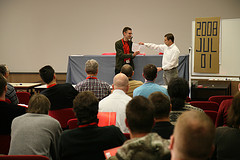 The day again started with the OOMPs. Bernard and I introduced our session with a little sketch where the customer asks the developer to implement a solution. At the end, Bernard gives me what I asked for. But then I realize it’s not what I need. Our session commercial was: “Has this happened to you? <most people in the audience assent or groan as they remember a painful situation like this> If you want to avoid this sort of situation in future, come to the session!” Of course, the real reason why people came to the session was because I promised that there would be chocolates and candy. That trick works at every OOMP 🙂
The day again started with the OOMPs. Bernard and I introduced our session with a little sketch where the customer asks the developer to implement a solution. At the end, Bernard gives me what I asked for. But then I realize it’s not what I need. Our session commercial was: “Has this happened to you? <most people in the audience assent or groan as they remember a painful situation like this> If you want to avoid this sort of situation in future, come to the session!” Of course, the real reason why people came to the session was because I promised that there would be chocolates and candy. That trick works at every OOMP 🙂
After the OOMPs, the EMC team discussed the role of the product owner, while the Sirris team presented the application of agile in projects where more than software is involved. The Security architecture workshop let participants experiment with defining and attacking security measures.
Agile requirements
 I attended the Agile Requirements session, led by Dave Nicolette and Lasse Koskela. We were supposed to write user stories, based on a (very brief) paper spec and with the aid of roving product owners Dave and Lasse. After the first round, the teams demanded an onsite customer/product owner because things went too slowly. So, one participant in each team acted as product owner, answering the team’s questions. Things went a bit smoother.
I attended the Agile Requirements session, led by Dave Nicolette and Lasse Koskela. We were supposed to write user stories, based on a (very brief) paper spec and with the aid of roving product owners Dave and Lasse. After the first round, the teams demanded an onsite customer/product owner because things went too slowly. So, one participant in each team acted as product owner, answering the team’s questions. Things went a bit smoother.
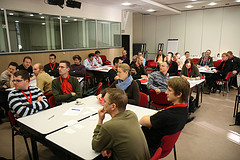 As Dave writes, the session veered off into a discussion about product owners and requirements. At one moment a team said their product owner was overwhelmed by being asked questions by 4 people and suggested to deputize one of the developers to talk to the product owner. A lot of discussion ensued about the (dis)advantages of this tactic. I agreed with Dave when he said that someday this whole team is going to learn to work together, so why postpone the learning by excluding part of the development team?
As Dave writes, the session veered off into a discussion about product owners and requirements. At one moment a team said their product owner was overwhelmed by being asked questions by 4 people and suggested to deputize one of the developers to talk to the product owner. A lot of discussion ensued about the (dis)advantages of this tactic. I agreed with Dave when he said that someday this whole team is going to learn to work together, so why postpone the learning by excluding part of the development team?
In the end, the whole discussion was academic, because, when we asked, the team’s product owner was not overwhelmed at all. He was doing fine. The team was (in Core Protocol terms) rescuing their product owner, helping someone without being asked to help. This doesn’t help, it only makes things worse. We’re better off treating all participants in the story writing exercise as adults. If the product owner is overwhelmed, they can say so. Everyone on the team is responsible for taking care of themselves.
In the afternoon, I missed the following interesting sessions:
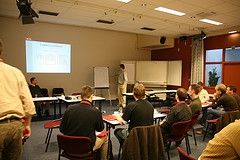 Laurent Bossavit presented personal productivity tools in Agile as lifestyle. As one participant said at the POOMPs: “It’s already changed my life!” The EMC team discussed release management and committing to fixed release dates. Nat Pryce and Steve Freeman hosted the Sustainable TDD session, for those practicing TDD. Keep your test as clean and clear as your code (if not clearer and cleaner).
Laurent Bossavit presented personal productivity tools in Agile as lifestyle. As one participant said at the POOMPs: “It’s already changed my life!” The EMC team discussed release management and committing to fixed release dates. Nat Pryce and Steve Freeman hosted the Sustainable TDD session, for those practicing TDD. Keep your test as clean and clear as your code (if not clearer and cleaner).
Koen van Exem and Walter Hesius presented Dimensional Planning, a way to get more value out of planning by considering the “depth” of implementation or refinement of a user story. I like the idea. Something similar came up in Jeff Patton’s keynote at XP Days London. Nicole Belilos hosted a retrospective about the conference, which gave us useful feedback for next year’s conference.
Where does it hurt? Interviewing techniques to really understand your customer
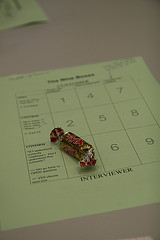 Bernard van der Beken and I hosted the “Where does it hurt?” session. In this game, participants learn to apply the “9 boxes” interview technique from Solution Selling. The goal of the technique is to discover the real problem the customer has, who is impacted by the problem (because these people will be interested in the solution) and to co-create with the customer a vision of the future where the problem is solved. It’s a really simple technique, but it requires concentration and training to really master. An important part are the confirmation questions, where you explain to the interviewee what you understood and ask if you got it right (a sort of acceptance tests for dialogue) . You can only continue if the customer says YES. If you haven’t understood, ask for clarification. All of these YESes from the customer have two effects:
Bernard van der Beken and I hosted the “Where does it hurt?” session. In this game, participants learn to apply the “9 boxes” interview technique from Solution Selling. The goal of the technique is to discover the real problem the customer has, who is impacted by the problem (because these people will be interested in the solution) and to co-create with the customer a vision of the future where the problem is solved. It’s a really simple technique, but it requires concentration and training to really master. An important part are the confirmation questions, where you explain to the interviewee what you understood and ask if you got it right (a sort of acceptance tests for dialogue) . You can only continue if the customer says YES. If you haven’t understood, ask for clarification. All of these YESes from the customer have two effects:
- You demonstrate at every step that you understand the customer, which gives them the assurance that you know what you’re doing, that you are on their side, that you really want to solve their problem, not just sell more of your product.
- Getting this YES at every step creates enthusiasm, especially in the co-creating the vision section. At the end of the nine boxes you and the customer have agreed on a shared vision! As one customer told me “Wow… this is the first time I’m actually excited to start an IT project!“
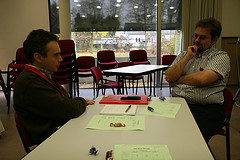 In the end, all of the participants were able to get to the shared vision with their customer and earned their “sales commission”: they could eat the candy on the playing field. Most people achieved this several times during the session
In the end, all of the participants were able to get to the shared vision with their customer and earned their “sales commission”: they could eat the candy on the playing field. Most people achieved this several times during the session
Dave Nicolette has a fantastic write-up of the session. The people from the Solution Selling blog responded. The 9 boxes is just one of the many useful techniques of Solution Selling. Buy the book or, even better, follow a Solution Selling course. This is one of the two most useful courses I have ever followed (I will tell you more about the other later).
Talking the senior management language
George Ataya gave a clear and funny presentation about senior management concerns. If we wish to be understood by senior management, we should state our problems and solutions using the framework given by the presentation. The presentation was followed by an exercise where we tried to do that. Unfortunately, the session was a bit short and I had to leave early to start the wrap-up and cleanup of the conference. I want to know more about the subject. I learned some more at XP Days London.
Wrapping up
 The conference closed with the final POOMPs. This time we had changed our process: we asked people to stand up if they had been to a session. It’s a lot easier to talk if you’re already standing up, so we got a lot more people to tell us about their experience at the sessions. The presenters got a bottle of “Carolus” beer before we went to the bar to continue the many conversations.
The conference closed with the final POOMPs. This time we had changed our process: we asked people to stand up if they had been to a session. It’s a lot easier to talk if you’re already standing up, so we got a lot more people to tell us about their experience at the sessions. The presenters got a bottle of “Carolus” beer before we went to the bar to continue the many conversations.
XP Day Benelux was great: lots of smiling faces, lots of discussions inside and out of sessions, enthusiasm, energy. The participants go back to work with fresh ideas and renewed energy.
We are not satisfied with the state of the industry. We can do better as a profession. We can change. We can make something better. Or as the commercial says “Hate something. Change something. Make something better.”;-)
You make XP Days Benelux 2008 better with the ideas you give us during the conference and on your feedback forms. You can make it even better by hosting a session or by participating in the organisation.
Hope to see you all again soon.
Thanks to Lasse Koskela for the use of his pictures.

